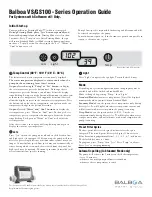
Masport P36-3 Gas Inbuilt
16
Diagram 3
HORIZONTAL
INSTALLATIONS
Install the flue system according to the
manufacturer's instructions included
with the components.
1) Set the unit in its desired location. Check to
determine if wall studs or roof rafters are in
the way when the flueing system is at-
tached. If this is the case, you may want to
adjust the location of the unit. Rough in the
gas preferably on the right side of the unit
and the electrical (junction block is on the left
side) on the left.
2) Put a bead of silicone inside the outer section
of the adapter and a bead of Mill-Pac on the
inner collar. Slip the adapter over the exist-
ing inner and outer flue collar and fasten to
the outer collar only with the 3 supplied
screws (drilling pilot holes will make this
easier). Level the fireplace and fasten it to
the framing using nails or screws through
the nailing strips.
3) Assemble the desired combination of pipe
and elbows to the appliance adaptor and
twist-lock for a solid connection.
Note: Apply sealant "Mill-Pac" to inner
pipe and high temperature silicone
sealant to outer pipe.
a) Horizontal runs of flue must be support-
ed every three feet. Wall straps are
available for this purpose.
4) Mark the wall for a 10" x 10" square hole.
The center of the square hole should line up
with the centerline of the horizontal pipe. Cut
and frame the 10 inch square hole in the
exterior wall where the flue will be terminat-
ed. If the wall being penetrated is construct-
ed of non-combustible material, i.e. mason-
ry block or concrete, a 7"(178mm) diameter
(7-1/2"(191mm) diameter for flex) hole is
acceptable.
Note:
a)
The horizontal run of flue must be
level, or have a 1/4 inch rise for
every 1 foot of run towards the
termination. Never allow the flue
to run downward. This could
cause high temperatures and
may present the possibility of a
fire.
b) The location of the horizontal flue termi-
nation on an exterior wall must meet all
local and national building codes, and
must not be blocked or obstructed. For
External Flue Terminal Locations, see
diagram on page 10.
5) The arrow on the flue cap should be
pointing up. Insure that the 1-1/2" clear-
ances to combustible materials are main-
tained. Install the termination cap, see dia-
gram 3.
The four wood screws provided should be
replaced with appropriate fasteners for
stucco, brick, concrete, or other types of
sidings.
Note: If installing termination on a siding
covered wall, a vinyl siding stand-
off or furring strips must be used
to ensure that the termination is
not recessed into the siding.
6) Before connecting the horizontal run of flue
pipe to the flue termination, slide the Wall
Thimble over the flue pipe.
Diagram 1
INSTALLATION
7) Slide the appliance and flue assembly to-
wards the wall carefully inserting the flue
pipe into the flue cap assembly. It is impor-
tant that the flue pipe extends into the flue
cap sufficient distance so as to result in a
minimum pipe overlap of 1-1/4 inches. Se-
cure the connection between the flue pipe
and the flue cap by attaching the two sheet
metal strips extending from the flue cap
assembly into the outer wall of the flue pipe.
Use the two sheet metal screws provided
to connect the strips to the pipe section. See
Diagram 2.
8) Install wall thimble in the center of the 10"
square and attach with wood screws. See
Diagram 3.
Diagram 2
















































